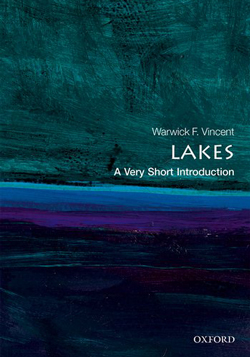
In the introduction to his book, Warwick Vincent states that its aim “is to provide a condensed overview of scientific knowledge about lakes”. Given that each individual lake can be considered as a unique environment reflecting the local hydrology, bedrock geology and the biology of its drainage basin, the author has set himself a considerable challenge to concisely review lake science or limnology in just 146 pages.
How well does he do? The answer, to my surprise, is extremely well. By using François Forel’s seminal work (“Notice sur l’histoire naturelle du lac Léman”, published in 1877 and three subsequent monographs published in 1892, 1895 and 1904, respectively) on Lake Geneva as a common thread, Vincent takes the reader through a brief but comprehensive review of the key aspects of limnology.
Chapter 2 reviews the different origin of lakes and the role of their sediments as archives of environmental change, the latter being lucidly illustrated by the very different but equally spectacular examples of Lake Chad and Walden Pond. Chapter 3 covers the physics of lake water and, as with the rest of the text, demonstrates the authors ability to cover a huge amount of technical ground (e.g. difference in origin of seiches and Poincaré Waves) both briefly and in an engaging manner. Chapter 4 considers the importance of microbes in lakes and Vincent’s quoting of Forel (“No serious analysis, to my knowledge, has indicated any lake water completely free of microbes…”) will ring a bell with geoscientists who are currently embroiled in the debate as to the relative importance of microbes in generating the thick Cretaceous carbonate lacustrine hydrocarbon reservoirs in the South Atlantic. Chapter 5 provides a good introduction to food chains/webs in lakes, including several sobering examples of the disruption and damage caused by invasive species. This chapter also epitomises one of the characteristics of the entire book, namely the impressive breadth of science covered in just a few pages. Extreme lakes (“water bodies that have unusual physical, chemical, and biological features”) are briefly but comprehensively, in terms of their diversity, covered in chapter 6, from saline lakes, polar and alpine lakes, to geothermal lakes.
Vincent concludes his short book with a chapter entitled “Lakes and us”. Each chapter is prefaced by a quote of Forel’s and the one chosen for the final chapter, “Humans exert a more powerful effect than any other animal on nature and its inhabitants”, seems especially prescient. The discussion contained in this chapter of the separate effects of damming and eutrophication is both very informative and extremely sobering.
The book is well illustrated, with 36 black and white diagrams and photographs, all of which are well-explained in the text. It also lists a very helpful selection of further reading and useful websites. I would thoroughly recommend this book not only to geoscientists looking for a sound introduction to lake environments, but also to anyone involved in Earth systems science as an example of an integrated approach which, according to Vincent, is the “hallmark of limnology”.
Reviewed by Andrew Barnett
LAKES: A VERY SHORT INTRODUCTION, by Warwick F. Vincent (2018), Published by: Oxford University Press, 168 pp. (pbk) ISBN: 9780198766735
List Price: £7.99
W: https://global.oup.com/